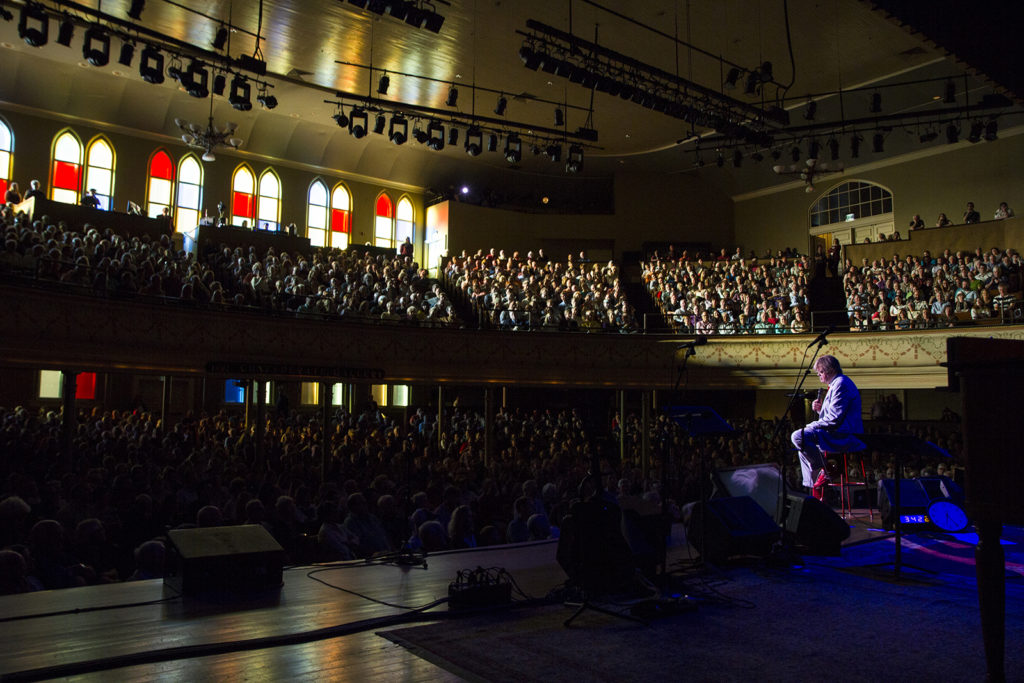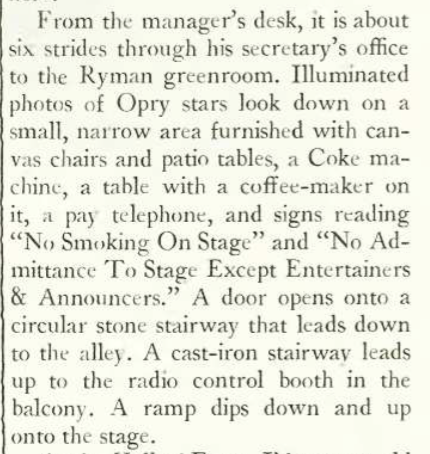
Nashville’s Ryman Auditorium is the backdrop for a story Garrison Keillor tells pretty frequently.
In 1974, the New Yorker magazine dispatched him to document the Grand Ole Opry. The show was moving out of the decaying “Mother Church of Country Music” and into new digs near Opryland. The experience changed his life. Within months, he was creating his own radio variety show. And 43 years later, Prairie Home Companion still airs every Saturday night, though now with a new host.
WPLN’s Blake Farmer spoke to Garrison Keillor, who is performing at the Ryman this weekend to celebrate the venue’s 125th year.
Links for Listening:

Tune in to the
first Prairie Home Companion show at Ryman Auditorium in 1994, just after a badly-needed renovation.
See
a timeline for PHC, from the New Yorker article to now.
Read
the New Yorker article that started it all (with subscription).
Download
TRANSCRIPT:
FARMER: Having heard about your first Ryman visit a time or two, I’ve wanted to know more about this New Yorker assignment. It just seems like it was so pivotal to your whole career. Who gave you this assignment?
KEILLOR: William Shawn was the editor of the New Yorker at the time. William Shawn was a man who seldom left New York City, and then often, reluctantly. But he was very curious about all sorts of things including — as it turned out — country music. He did not drive a car. I don’t know that he heard much country music. But I think he came across some lyrics that intrigued him. So he called on me to go down to Nashville.
FARMER: Did you welcome this idea?
Of course. I’d been down there the year before because I was curious about the Opry. I got to hear it up in Minnesota. The AM signal came in pretty well in the winter. And we used to string an aerial, by brother and I, out the window of our bedroom, and we could pick up the Opry. It sounded different from other shows because it had an audience. This was very interesting to us. And it was live, and you could tell that. So there was a vibe about it. And we come from fundamentalist people and country music does have some roots in gospel music. Much of it is gospel music about sinners. And so that appealed to us as well. So yes, I had a little bit of a history with the Opry.
FARMER: Well, you wrote in this article, which I dug up from the New Yorker archives, that you had tried to see the Opry in person before, I guess even made the drive from Minnesota, but tickets were sold out. Were you a big country music fan?
KELLIOR: Yes, I stood out in the parking lot. The windows were open because they had no air conditioning, and I looked in through the windows, and I could see the lower halfs of the performers and all of some of the shorter performers, like Stonewall Jackson. You could see all of him. I could see the lower two-thirds of Dolly Parton, and I stood out there. There were a lot of people out there in the parking lot who had driven a long way and we could hear it on the radios of cars and pickup trucks parked out there. It was a whole scene. Also, there was beer involved, but you know, that wasn’t crucial.
FARMER: You returned to the Ryman in 1994, when it reopened after a big renovation. I suppose it was the first time you performed a Prairie Home Companion there. I pulled some audio from your monologue that evening. We’re going to listen real quick.
KEILLOR ARCHIVE: “So it’s a powerful feeling to come and visit the sight of yet another of life’s haphazard decisions. to think about who that young man was sitting up there in the balcony. he was 32 years old, discontented and confused, and he was looking at the people on the stage thinking how was he ever going to get this down on paper.”
FARMER: There’s a lot going on there, but start with this: What was the pry like back in those days? Because I’ve been to the Opry in recent years, and I’ve been to your show many times, and they have a very different feel. Which is closer to what you saw back in 1974?
KEILLOR: Well the show back in 74 had Roy Acuff and his band. There were more what I would call traditional musicians. There were also big stars. I mean, Loretta Lynn was there and she was huge at the time. Dolly Parton was coming on. Porter Wagoner was there. But it was much more of a down home sort of a show. It had not been so affected by pop as it is today.
FARMER: It sounds like you’re saying Prairie Home Companion as it’s been in recent years would be something a bit closer?
KEILLOR: Oh I think so, I think so. But I have such a poor memory of shows. This happens when you do a weekly show. You never remember the ones you’ve done. You’re always looking forward to the next Saturday. So I’m the least nostalgic person I know. I’m pretty well lost talking about the past.
FARMER: Well, you seem to have a pretty good recall. So let me ask you about the Ryman itself back then. You called it a “mammoth brick tent,” which I think is just such a great description. It’s just so polished up and revered now. I think it’s almost hard to understand what it was like back in 1974. What did it look like? What struck you?
KEILLOR: Well they had done some work on it to fit the Opry in. They had a radio broadcast booth up stage left, up where the balcony had been, wrapped around the back of the stage. Practically no dressing rooms, so everybody just came already dressed. There was one dressing room off to stage right where Roy Acuff hung out and various pickers came in to jam with him and his band members. Bashful Brother Oswald was in there and others. It was really looked pretty much as it had back in its gospel tabernacle days. And it was very easy to imagine a preacher up on stage, bending into his message and people sitting and sweating down below.
FARMER: Well, people were even talking about it needing to be torn down. Could you see why?
KEILLOR: Well, it was in a state of disrepair, that’s for sure. There were holes in the roof and water was leaking in. I think there were plenty of people who were content to let it just fall down. I don’t know that people were talking about demolishing it. But I think it just stood there, neglected. But what the insurance company discovered, what National Life and Casualty discovered, was that there were still people interested in seeing it. So they opened it up for tours, though there were no performances in there. And there were crowds of people in line to pay money to see the inside of this old, deteriorating hall. And that, I think, convinced people at last who had to make the decision, convinced them that this was a real tourist attraction for Nashville. And beyond that, it was also very valuable performing space.
FARMER: You seem to, not just the Ryman, but you seem to revere old theatres just generally. What is it about old theatres to you?
KEILLOR: Well, I was forbidden to go to the theater when I was young because they showed movies and movies were of Hollywood and Hollywood glorified wayward people and their misadventures. So when you’re warned against something so acidulously you develop a fatal attraction toward it. I love going into movie theaters. But they don’t have to be old. The lights go down, you don’t notice anymore. It’s one of the pleasures of life, seeing the lights go down and the lights go upon the screen. Or on stage, either one. Even in the era of the Youtube and streaming and all, people still love to go and see actual people come out on stage or watch a movie on a big silver screen.
FARMER: Which I guess was so much different than the time you were sort of chronicling the movement of the Opry. But tell me about this 32-year-old writer. You wrote that you were wearing a white linen suit, brown cowboy hat and cowboy boots — which is kind of a far cry from the red sneakers you’re known for now. I’m just wondering, did you really just sitting there in the balcony of the Ryman just get so intrigued that you were convinced you should quit this coveted job at the New Yorker and try something just like it?
KEILLOR: I didn’t have a job at the New Yorker. I was a freelance writer. I had sent them a story back in 1969 and they bought it. And they published it. Which at the time, for a writer from Minnesota, was so prestigious. And yet, all the time I was trying hard to be published in the New Yorker, I also had the feeling that I was trying to be somebody I was not. I was trying to be a New York writer and trying to adopt the attitudes and the styles of writers I admired — A.J. Leibling and John McPhee. And I couldn’t quite manage it.
FARMER: What do you mean, like you were an imposter or something?
KEILLOR: I was, I was an imposter. This article about the Opry, which opened the door to starting a Prairie Home Companion, which opened the door to talking about a small town in Minnesota also gave me something that was closer to an authentic voice than what I had written for the magazine. I loved reading the magazine, I still do, I wish them well, but it’s not my medium. And I’m glad that I found it at the age of 32.
FARMER: I know you’re writing a memoir now. And I wonder when you look at the course of your 75 years, where does this Prairie Home origin story fit in? Does a Prairie Home Companion ever start without this train ride down to Nashville to catch the last [Opry] show at the Ryman?
KEILLOR: No it does not, it does not. Because I was not a performer, had no interest in being a performer. Never did theater in school. I never stood up in front of an audience before. But it was seeing other people do it in that particular context, seeing comedy — Minnie Pearl out on stage — doing this rube comedy that went way back to tent shows. It was very moving. And it was a show that was about the audience. That was the amazing thing about it. The audience was so tremendously loyal. These people on stage were speaking for the people in the pews. And so there was really a religious fervor about it. This was something you could not help but notice.


